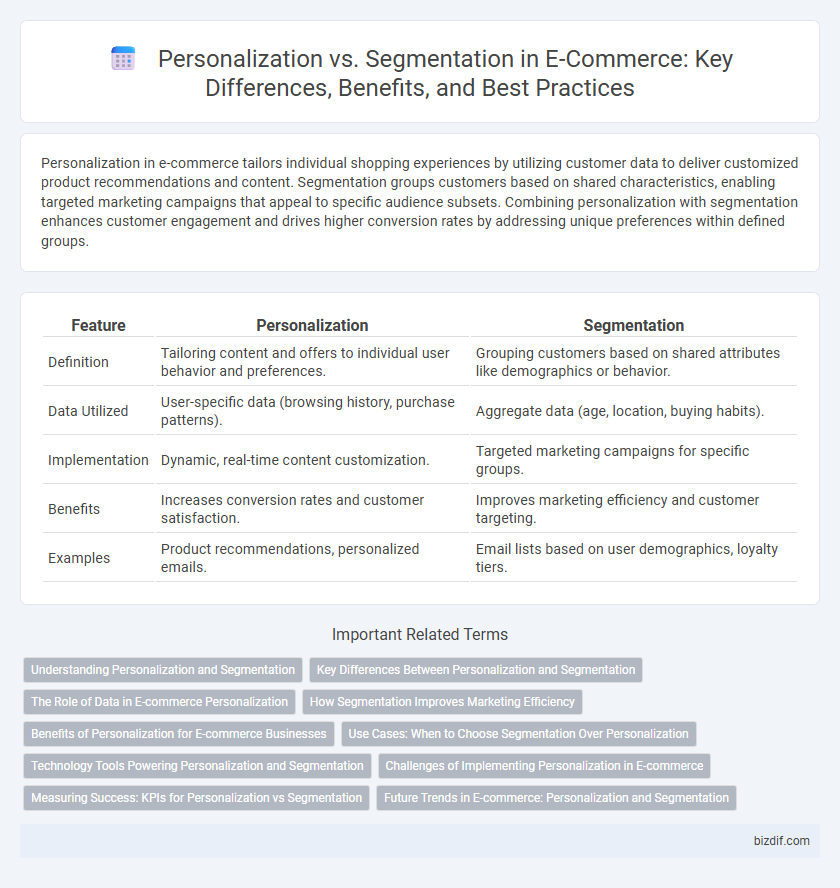Personalization in e-commerce tailors individual shopping experiences by utilizing customer data to deliver customized product recommendations and content. Segmentation groups customers based on shared characteristics, enabling targeted marketing campaigns that appeal to specific audience subsets. Combining personalization with segmentation enhances customer engagement and drives higher conversion rates by addressing unique preferences within defined groups.
Table of Comparison
| Feature | Personalization | Segmentation |
|---|---|---|
| Definition | Tailoring content and offers to individual user behavior and preferences. | Grouping customers based on shared attributes like demographics or behavior. |
| Data Utilized | User-specific data (browsing history, purchase patterns). | Aggregate data (age, location, buying habits). |
| Implementation | Dynamic, real-time content customization. | Targeted marketing campaigns for specific groups. |
| Benefits | Increases conversion rates and customer satisfaction. | Improves marketing efficiency and customer targeting. |
| Examples | Product recommendations, personalized emails. | Email lists based on user demographics, loyalty tiers. |
Understanding Personalization and Segmentation
Personalization in e-commerce tailors the shopping experience to individual customers based on their behavior, preferences, and purchase history, enhancing user engagement and conversion rates. Segmentation divides the customer base into distinct groups using demographic, geographic, or psychographic attributes to target marketing efforts more effectively. Understanding the nuances of personalization and segmentation enables businesses to deliver more relevant content, increase customer loyalty, and optimize marketing ROI.
Key Differences Between Personalization and Segmentation
Personalization in e-commerce tailors the shopping experience using individual customer data such as browsing history and purchase behavior, while segmentation groups customers based on shared characteristics like demographics or buying patterns. Personalization delivers unique product recommendations and content for each user, enhancing engagement and conversion rates. Segmentation provides targeted marketing campaigns to broader customer groups, optimizing resource allocation and increasing campaign relevance.
The Role of Data in E-commerce Personalization
Data plays a pivotal role in e-commerce personalization by enabling the collection and analysis of individual customer preferences, behaviors, and purchase histories to tailor product recommendations and user experiences. Unlike segmentation, which groups customers based on broad categories such as demographics or location, personalization leverages real-time data and machine learning algorithms to deliver unique, dynamic content for each user. Harnessing data effectively improves conversion rates, customer satisfaction, and long-term loyalty through precise targeting and customized marketing strategies.
How Segmentation Improves Marketing Efficiency
Segmentation improves marketing efficiency by dividing a diverse customer base into specific groups based on demographics, behavior, and purchasing patterns, enabling more targeted and relevant messaging. This precision reduces ad spend waste and increases conversion rates by addressing the unique needs of each segment. Leveraging data analytics for segmentation allows e-commerce businesses to optimize campaigns, enhance customer engagement, and boost overall ROI.
Benefits of Personalization for E-commerce Businesses
Personalization in e-commerce enhances customer experience by delivering tailored product recommendations based on individual browsing and purchase history, increasing the likelihood of conversions. It enables dynamic content adjustment, improving engagement and fostering customer loyalty through relevant offers and promotions. Furthermore, personalization drives higher average order values and repeat purchases by addressing unique shopper preferences more precisely than broad segmentation.
Use Cases: When to Choose Segmentation Over Personalization
Segmentation proves more effective than personalization when targeting broad customer groups with similar behaviors or demographics, such as offering region-based promotions or seasonal campaigns. It simplifies marketing strategies by categorizing users into distinct groups, facilitating scalable email marketing and targeted ad campaigns. E-commerce platforms leverage segmentation to optimize resource allocation while addressing the needs of large customer segments, improving engagement without the complexity of one-to-one personalization.
Technology Tools Powering Personalization and Segmentation
Technology tools powering personalization in e-commerce leverage AI-driven algorithms and machine learning to analyze individual customer behavior, enabling tailored product recommendations and dynamic content delivery. Segmentation relies on customer data platforms (CDPs) and automated marketing software to group users based on shared demographics, purchase history, and browsing patterns for targeted campaigns. Advanced analytics platforms integrate both approaches, optimizing real-time decision-making to enhance customer experience and increase conversion rates.
Challenges of Implementing Personalization in E-commerce
Implementing personalization in e-commerce faces significant challenges including data privacy concerns, complex integration of AI-driven recommendation systems, and real-time data processing demands. Ensuring accurate customer profiling while complying with GDPR and CCPA regulations complicates the use of personal data for tailored experiences. Balancing scalability and customization often requires advanced infrastructure and continuous optimization of machine learning algorithms to effectively enhance user engagement and conversion rates.
Measuring Success: KPIs for Personalization vs Segmentation
Key performance indicators (KPIs) for personalization include conversion rate, average order value, and customer lifetime value, which directly measure individual customer engagement and satisfaction. In segmentation, KPIs such as segment-specific sales growth, click-through rates, and churn rate help evaluate the effectiveness of targeting distinct customer groups. Tracking these metrics allows e-commerce businesses to optimize marketing strategies by comparing the impact of personalized experiences versus segmented campaigns.
Future Trends in E-commerce: Personalization and Segmentation
Future trends in e-commerce reveal an increasing blend of personalization and segmentation powered by AI-driven data analytics, enabling hyper-targeted marketing strategies that boost customer engagement and conversion rates. Advanced machine learning algorithms analyze individual browsing behavior and segment-specific preferences simultaneously, creating tailored shopping experiences that adapt in real-time. Integrating predictive analytics with dynamic content delivery will further enhance personalization, making segmentation more precise and effective in driving sales growth across diverse consumer groups.
Personalization vs Segmentation Infographic

 bizdif.com
bizdif.com